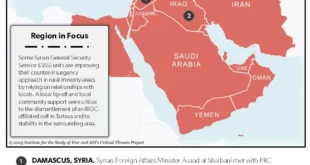After the Cold War, the US stood as the sole superpower providing the necessary stability for globalization. Many business executives today have only ever operated in the world America built. A world where international laws are largely respected and enforced, where freedom of navigation is a given and interstate conflicts are rare and geographically contained. However, those days are gone. America’s hegemonic power has dwindled, and an unstable multipolar system is taking its place.
An “Axis of Disorder” comprising China, Russia, North Korea and Iran is rising and seeks to undermine US power. The members of this Axis are creating a more unpredictable and fragmented global landscape, fraught with uncertainties. This new reality has increased physical, social and cyber risks from state, non-state and individual actors. These threats concern not only the US and its allies but also international corporations with employees, assets and infrastructure around the globe.
Businesses are now faced with navigating these challenges. Global Guardian’s new Worldwide Threat Assessment explores the effects of this changing order. These ramifications will reverberate across industries and nations, creating tumult that demands business executives to have a prepared response.
US power is diminishing
The peace and stability of the last three decades are gone. The US has fallen back from the leading role on the geopolitical stage economically and militarily. As a result, geopolitics is back and with a bite.
In recent years, the relative economic power of the West has diminished. In 2000, America, Canada, France, Germany, Italy and the United Kingdom — known as the Group of Seven (G7) — represented 43% of the world’s GDP in purchasing power parity (PPP). Unencumbered, this bloc could project economic and military force globally. In the same year, Brazil, Russia, India, China and South Africa (BRICS) — the alternative to Western alliances — accounted for 18% of global GDP (PPP). However, by 2023 the BRICS share had soared to 32% as the G7 share dropped to 30%. The relatively weak position of the G7 has deprived Washington and her closest allies of a major lever for enforcing world order: sanctions.
Once a powerful deterrent and coercive tool, sanctions are now ineffective against regional and near-peer powers. In response to Russia’s invasion of Ukraine, the West capped the price of Russian oil imports (with the US and UK outright banning oil and gas imports), froze Russian assets and barred the sale of certain technologies to Russia. While these measures will impact Russia over the long term, they have not slowed the Russian war machine in the near term. These measures didn’t exactly deliver a knockout blow.
Despite the sanctions, Russia has increased its oil exports to China and India utilizing a “shadow fleet” of tankers to continue exporting millions of barrels of crude oil every day. Furthermore, Russia has been importing Chinese technology and rerouting sanctioned European goods through Central Asian third-party countries. Doing so has allowed the country to acquire the chips, transceivers and other components it needs to produce military equipment even faster than before the war.
As sanctions lose effectiveness, American interest in spending resources on foreign engagements has also dwindled. This decline stems from multiple factors: mission creep from the “War on Terror,” extensive state-building efforts and escalating domestic political polarization. The US military and its military-industrial base are under intense strain, compounded by recruitment struggles and various internal woes that are weakening military readiness capabilities.
America’s withdrawal from Afghanistan in 2021 was a clear sign to foreign leaders that the US no longer has an appetite for foreign wars. Less than three years after exiting Afghanistan, cold conflicts have broken out into full-scale wars in Eastern Europe and the Middle East. Other nations, emboldened, are now taking actions they previously avoided due to fear of American retaliation. With the world in flux, more geopolitical conflict and chaos is expected, especially as the longstanding global referee appears to be retiring.
The Axis of Disorder is rising
The perception of American weakness signals an opening for other nations to assert themselves as global and regional powers. The “Axis of Disorder” — China, Russia, North Korea and Iran — is challenging the existing Western-dominated world order. Each member is facing American containment policies, whether military, economic, or both. As America’s positions continue to erode in Eastern Europe, the Indo-Pacific and the Middle East, the Axis sees a chance to rid themselves of American influence and dominate their regions.
The Axis of Disorder is now collaborating at unprecedented and dangerous levels to undermine the United States. Iran has sent Russia hundreds of drones and licensed their domestic production in Russia. North Korea is shipping millions of artillery rounds to support Russia’s war in Ukraine. China is providing Russia with capital and goods to bypass Western sanctions. This creates a multipolar system replete with instability and heightens the threat of global disruptions. As a result, corporations now face a more unpredictable global landscape.
The basic realities of doing business overseas have materially changed. Decoupling with China and Russia, sticky high interest rates and the unstable geopolitical environment are all issues that businesses must grapple with. Companies, especially in the manufacturing space, need to work with greater redundancy to continue to operate and scale. Conflicted shipping lanes also force costly reroutes and drive up insurance premiums, further straining margins. All of these factors create even higher prices across the board for manufacturers, sellers and consumers.
In the short term, having a high-level corporate strategy with risk management and duty of care must be a priority for companies with international operations. Members of the C-Suite — including chief executive officers, chief strategy officers, human resources directors, chief information officers and general counsels — must have resiliency plans in place to cover all possible threats. It is critical for companies to run through tabletop exercises so all parties involved understand their roles and responses during emergencies that could derail global operations.
In the medium and long term, executives must pivot from a reactive posture to proactive preparation. Business leaders should explore alternative sourcing outside of politically turbulent regions. Replicating supply chains in other markets can save businesses from significant disruption during conflicts. The need for nearshoring has become increasingly clear as businesses and their customers face the economic impact of growing international tensions. Continued reliance on unstable supply chain choke points exposes businesses to greater risk and hampers the ability to meet consumer demand. While these measures are not cheap, they are essential to building resilience to withstand today’s unstable geopolitical environment.
As American hegemony slips, the fundamental pillars of our global economy continue to erode. Companies must adopt a proactive approach to risk and have plans for when, not if, a crisis occurs. Businesses that fail to recognize and prepare for the new threat landscape will fall behind when these threats become headlines. The worst-case scenario is one for which there is no plan. Now is the time for planning and finding the right partnerships to protect your people.
 Eurasia Press & News
Eurasia Press & News



